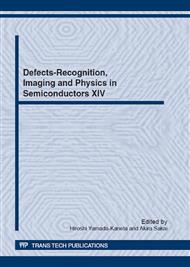p.213
p.217
p.221
p.227
p.231
p.235
p.239
p.243
p.247
Reliability Improvement in Silicon Dioxide
Abstract:
There are two typical methods for silicon oxidation. One is pyrogenic oxidation using oxygen and hydrogen, the other is dry oxidation using oxygen. In this study various properties of these oxidation films were compared. The pyrogenic oxidation in turn could show better characteristic values in the all experiments. Furthermore, once dry oxidation was used even before gate oxidation, we found that dry oxidation made a source of defects generation at surface of the Si substrate.
Info:
Periodical:
Pages:
231-234
Citation:
Online since:
July 2012
Authors:
Price:
Сopyright:
© 2012 Trans Tech Publications Ltd. All Rights Reserved
Share:
Citation:


